Black Spiders With White Spots (With Pictures) – Identification Guide
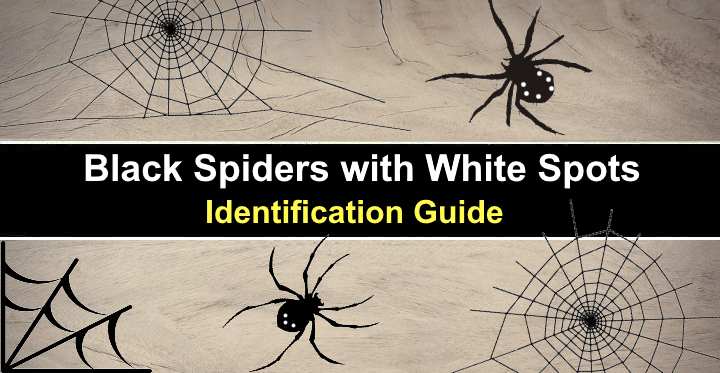
Seeing a black spider with white spots scurrying across the floor is enough to send you into a frenzied panic. Or you may have noticed a white-spotted black spider outside in the yard and wonder if the spider is dangerous or not. Identifying black spiders that have white markings is vital to identify harmless spiders from venomous, biting spiders.
White spots on black spiders make the type of spider relatively easy to identify. Typically, only a few species of black and white spiders exist. And the most common white-dotted black spider is the hairy jumping spider. However, several other black spider species have identifiable white patches.
This article is a comprehensive guide to help identify black spiders with white spots. Descriptions and pictures of the eight-legged creepy crawlies will make it easier to recognize panic-inducing creatures.
Types of Black Spiders With White Spots
Like all spiders, black and white spiders are eight-legged arthropods in the class Arachnida. Black spiders with white dots are grouped into various genera. Among the types of black spiders you are likely to come across are jumping spiders, purseweb spiders, orb weavers, and black widow spiders.
Suppose you notice a hairy black spider with white spots on its back. In that case, you shouldn’t worry. This is probably a harmless type of black and white jumping spider. But noticing a small black spider with a bulbous body and white and red markings is more worrying. This type of spider could be a dangerous black widow species.
How to Identify Black Spiders With White Spots
The way to identify a spider with white spots and a black body is by looking at its body shape, type of white patches, and if it has hairs or not. Black and white spider identification is also possible by observing the spider’s habitat and the type of web it spins.
For example, a jumping spider is easily recognizable due to its robust, hairy body and three white abdominal spots. A purseweb spider looks similar but has a hairless black body and a white band across its back. But unlike a purseweb spider, a jumping spider doesn’t spin webs.
However, a black widow with white dots has a rounded body and thin legs, and spins messy webs. But sometimes, black widow spiders are easily confused with the false widow—an orange-legged spider with a black egg-shaped body and oval white spots.
Types of Black Spiders With White Spots (With Pictures) – Identification Guide
There are several kinds of black spiders that have white spots. Some white-spotted black spiders are venomous, while others are not. In addition, some black and white spiders have the ability to run and jump to catch prey, whereas others spin intricate webs. Please read on to learn the habits and identifying features of these unusual spiders.
Zebra Jumping Spider (Salticus scenicus)
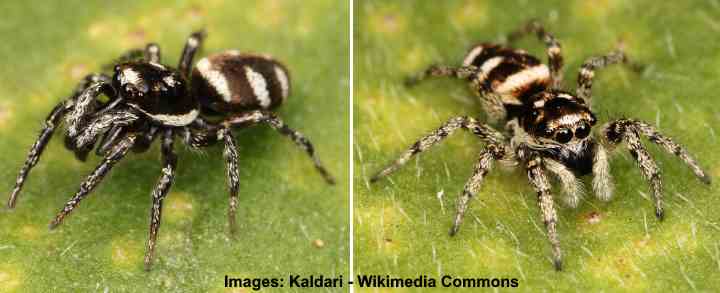
Zebra jumping spiders have black and white patterns on their body. In the pictures: male (left) and female (right)
The zebra jumping spider is easy to identify because of its distinct black and white patterning. The furry spiders have an egg-shaped abdomen and oval, flattened cephalothorax. It’s also identified by its black, white-spotted legs and large eyes on its head. The zebra jumping spider measures 0.19” to 0.35” (5 – 9 mm) long.
The small black and white zebra jumping spiders are typically harmless and don’t spin webs. Instead, they use their excellent vision to stalk and hunt prey. The black spider with its white spots, stripes, and short, stocky legs is often found in gardens and open habitats.
If you spot a black and white zebra jumping spider at home, it is probably lurking in the corner of window sills.
Black Spider With White Spots Identification
The zebra jumping spider is a tiny black spider, identified by its white bands and spots on its abdomen and short legs. The small spider has eight eyes, two of which are prominent on its round head.
Bold Jumping Spider (Phidippus audax)
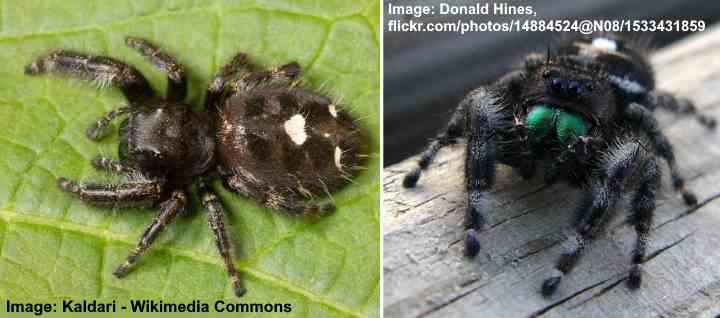
The bold jumping spider is identified by its black hairy body and 3 white spots on its back
The bold jumping spider is a black furry spider with three heart-shaped spots on its egg-shaped abdomen. Other identifying features of the black spider are its fuzzy black legs with grayish-white bands, large iridescent chelicerae (mouthparts), and soft setae (hairs) on its body.
The black and white bold jumping spider measures 0.15” to 0.7” (4 – 18 mm) long. Although the white spots on its black body are its most identifiable characteristic, the jumping spiders in warmer regions can have different colored spots. For example, bold jumping spiders in Florida can have red, orange, or yellow spots.
Like all species of jumping spiders, these arachnoids don’t spin webs to catch prey. Instead, they hunt small insects, chasing them down and killing them.
The bold jumping spider isn’t harmful to humans. But, of course, all spiders can bite, and white-spotted black jumping spiders may bite when cornered. However, it is very rare for the spider to bite humans.
Black Spider With White Spots Identification
The bold jumping spider is identified as a black spider with three dots on its back and eye-catching greenish metallic mouthparts.
Black and Red Jumping Spider with White Dots (Phidippus clarus)
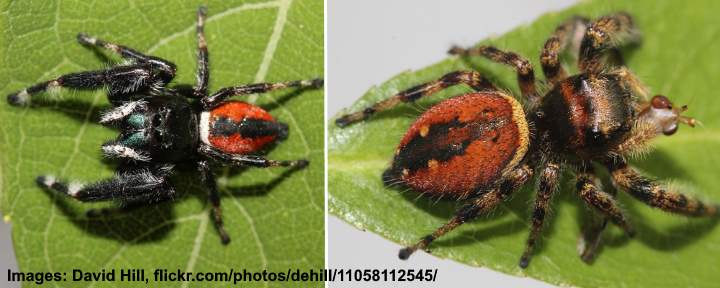
Phidippus clarus is a jumping spider with an orange abdomen and a black stripe. In the pictures: male (left) and female (right)
Sometimes called the brilliant jumper, this colorful spider has a black and red abdomen with a white band below its cephalothorax. The male Phidippus clarus species has a black furry body with red and white markings. Other features are its bluish-green metallic chelicerae and fuzzy black and white forelegs.
The black and red Phidippus clarus measures 0.16” to 0.55” (4 – 14 mm) long. It is often found in gardens, waiting on the underside of leaves to jump on passing prey. This white-dotted red and black spider is found throughout North America.
Black Spider With White Spots Identification
The Phidippus clarus is a species of jumping spider with a recognizable black body with two orange-red abdominal stripes and a white band between the abdomen and head.
Eastern Parson Spider (Herpyllus ecclesiasticus)

The eastern parson spider is an aggressive spider with distinctive white-gray markings on its black abdomen
The eastern parson spider has a slender black body, large, long legs, and a white-gray spot on its back. The dull white-gray spot is in the shape of an old-style cravat. In addition, the dark-colored spider has brown, spiny legs, a dark brown oval head, and pronounced spinnerets.
The eastern parson spider measures 0.4” to 0.8” (1 – 2 cm) long. The predatory spider is often found under garden debris, rocks, or log piles. It may sometimes find its way into your home in the fall. Although it’s classified as a harmless black spider, it can bite when threatened.
Black Spider With White Spots Identification
The identifying features of the eastern parson spider are its fuzzy elongated abdomen with a white geometric pattern on its back. This spider is classed as a ground spider in the family Gnaphosidae.
Purseweb Spider (Atypus baotingensis)
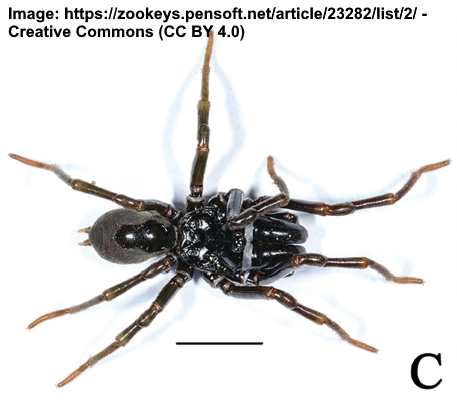
The purseweb spider has a shiny black body with 2 grayish-white elongated spots that create a stripe on its head
The purseweb spider is a smooth-bodied, shiny black spider with a noticeable whitish-gray band on its cephalothorax. Identifiable features of this black spider are its oversized mouthparts (chelicerae), sprawling black legs, and low stance. The large black spider measures 1.25” (31 mm).
Purseweb spiders have an unusual habit of using their webs to catch prey. First, they spin a tube-like web and hide inside. Then, they wait for insects to land on the web, then bite through the web and pull their meal inside. Purseweb spiders are typically active in spring and early summer.
Black Spider With White Spots Identification
The black and white-banded purseweb spider has a smooth black body with two large rectangular spots forming a white band on its head.
Crablike Spiny Orb Weaver (Gasteracantha cancriformis)
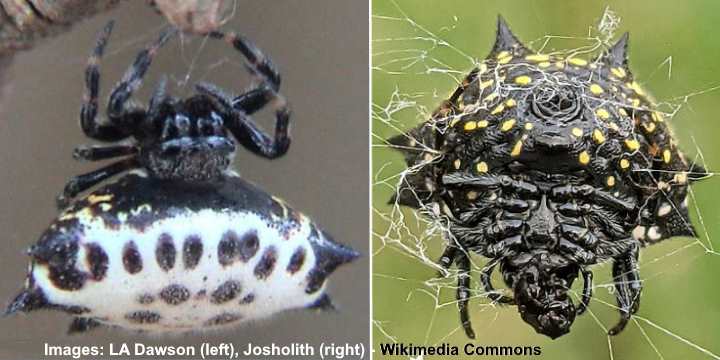
The underside of the crablike spiny orb weaver is black with white and yellow dots
One of the most unusual black and white spiders is the crablike spiny orb weaver. The strange underside of the spider’s abdomen and legs are black with spots. Typically, the top of the abdomen is white with black spots and six red or black conical projects around its edge.
Spiny-backed orb-weavers have an abdomen wider than it is long. In comparison, its head is tiny, and it has small legs. The black and white spider measures 0.39” to 0.51” (10 – 13 mm) wide and 0.2” to 0.35” (5 – 9 mm) long.
As its common name suggests, this spiny-backed spider spins orb webs up to 12” (30 cm) across. The tiny garden spiders use their ornate webs to catch small insects. You will often find the spiders in the southern United States. The species also have wide color variation, with yellow and black spiders the most striking.
Black Spider With White Spots Identification
The easy-to-identify spiny-backed orb-weaver has a yellow and white-spotted black lower abdomen and white top with black spots and distinctive fleshy spines.
Black Widow (Latrodectus elegans)
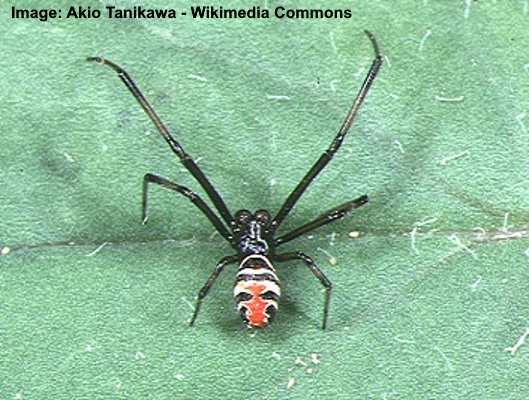
Some species of Latrodectus elegans have white, black and red markings on their back
The black widow is a dangerous common house spider, identified by its characteristic red hourglass marking on its abdomen. However, some male species of Latrodectus elegans have white spots or bands on their back. The biting, venomous spider has eight legs, and the front two are particularly long.
You don’t need to be too scared if you notice a black and red widow spider with white abdominal markings. The male black widows are harmless and don’t have the venom that the females have. Latrodectus elegans measures 0.39” (10 mm) and has a leg span of 1.18” (30 mm).
Black Spider With White Spots Identification
The distinctive black widow Latrodectus elegans is identified by its shiny black oval body with white and red patches on its abdominal area.
False Widow Spider (Steatoda washona)
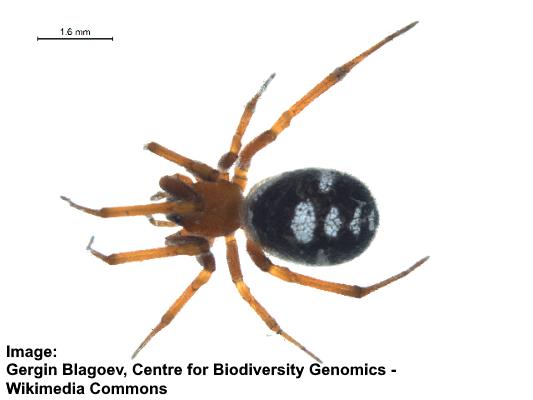
The false widow spider has brown head and legs, as well as white spots on its black abdomen
The false black widow spider has a bulbous black abdomen with several white spots, orange-brown legs, and a brown head. However, it’s easy to distinguish this spider from a true black widow because it only has white spots on its black abdomen, not red markings.
The black and brown spider may look like a brown black widow, but its venom isn’t as harmful. Some people compare the pain of a false widow bite to a bee sting. The white-spotted false widow spider is classed as a tangled-web spider due to the messy webs it creates to catch its prey.
This spider hides in undisturbed, dark places like closets, under furniture, in outbuildings, and cabinets. Some species of false widows have the common name cupboard spider because they are often found there.
Black Spider With White Spots Identification
The identifying features of the false widow spider are its multiple white spots on its egg-shaped black oval abdomen.
Spotted Ground Swift Spider (Nyssus coloripes)
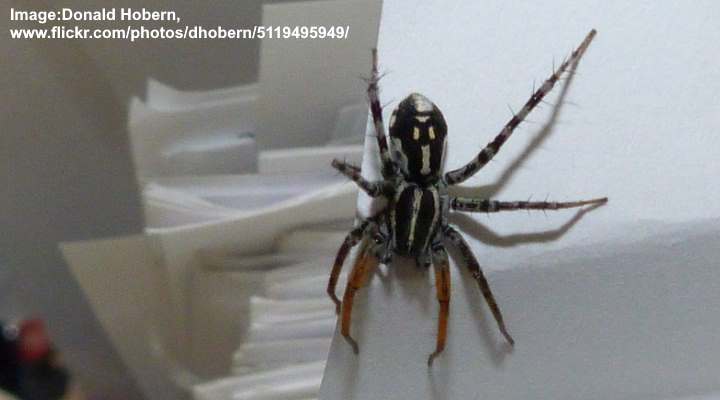
The spotted ground swift spider can be identified by its black body covered in white spots and stripes and 2 orange forelegs
The spotted ground swift spider is a distinctive orange forelegs spider with a black body covered in white spots and stripes. Pictures of this fast-moving black and white spider show it has an oval black abdomen with bands of white spots, white stripes on its cephalothorax, and white markings on its rear legs.
The white-spotted black spiders are known for their swift running movements. Therefore, they are sometimes called the fleet-footed spider. However, it’s also called the painted swift spider due to its white markings.
The spotted ground swift spider typically measures 0.23” – 0.27” (6 – 7 mm) long.
Black Spider With White Spots Identification
The spotted ground swift spider is identified by its black appearance with white spots covering most of its body. Its orange forelegs are also a distinguishing feature.
Peppered Jumping Spider (Pelegrina galathea)
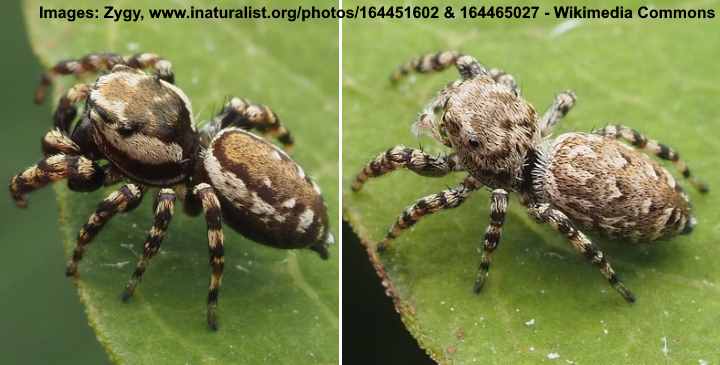
Peppered jumping spiders: male (left) and female (right)
The peppered jumping spider is a dark brown, almost black spider with creamy-white or tan-colored spotted patterns. An unusual identifying feature of the peppered jumping spider is that its cephalothorax is as large as its abdomen. The small native North American spider measures 0.14” to 0.21” (3.6 – 5.4 mm) long.
Like all jumping spiders in the family Salticidae, the peppered jumping spider has a stout body, short, stocky legs, eight eyes, rectangular head, and egg-shaped abdomen.
These small grayish-black or brown spiders are often found in grassy areas outdoors. Although the tiny white-spotted spiders can bite, they are not harmless and only bite when they feel threatened.
Black Spider With White Spots Identification
The peppered jumping spider is identified by its dark-colored body, white-banded legs, and abdomen covered in whitish-tan spots and markings.
Long-Palped Ant Mimic Sac Spider (Castianeira longipalpa)
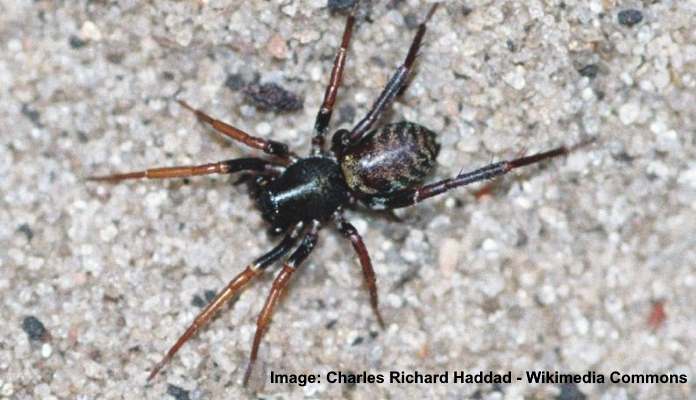
Long-Palped Ant Mimic Sac Spider (Castianeira longipalpa)
The Castianeira longipalpa is a brown and black spider with white spots on its shiny oval abdomen. The black and white spider has several whitish bands on its abdominal region made up of tiny white dots. Other identifying features of the spider are its black or dark brown banded legs.
The small black spider measures around 0.5” (13 mm) long, and the males are significantly smaller. Although blackish-gray is the spider’s typical color, there is also color variation in the species. Some spiders are brown or black with orange bands on their legs and abdomen.
Long-palped ant mimic spiders are common throughout the United States.
Black Spider With White Spots Identification
The small black spider is identified by its four or more spotted white bands along its abdomen. An identifying feature is its two pairs of front legs that are close together.
White-Tailed Spider (Lampona cylindrata)
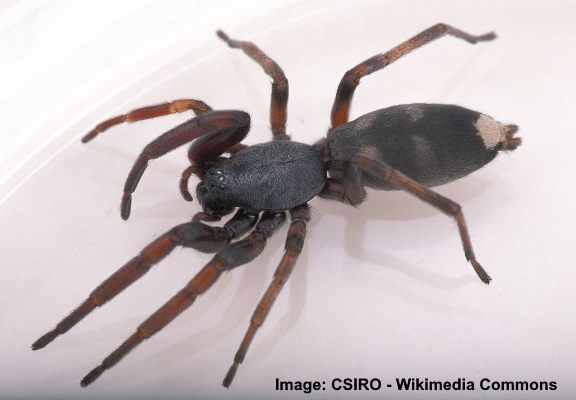
The white-tailed spider has a black body, reddish-brown legs, and a whitish spot at the end of its back
The white-tailed spider is a slender black spider with a single white spot at its spinnerets. Characteristics of this hunting spider are its reddish-brown legs, faint grayish markings on its abdomen, and large leg span. The white-tailed spider grows 0.7” (1.8 cm) long and has a leg span of 1.2” (3 cm).
A white-tailed spider’s bite may cause localized pain, redness, swelling, and itchiness. However, the spider bite is typically harmless and doesn’t cause necrosis or skin infections. It’s usually found in gardens, but the spider will find its way into homes in cooler weather.
Black Spider With White Spot Identification
The white-tailed spider is a species of black spider with a recognizable white patch at its tail end and mahogany brown legs.
Related articles:
